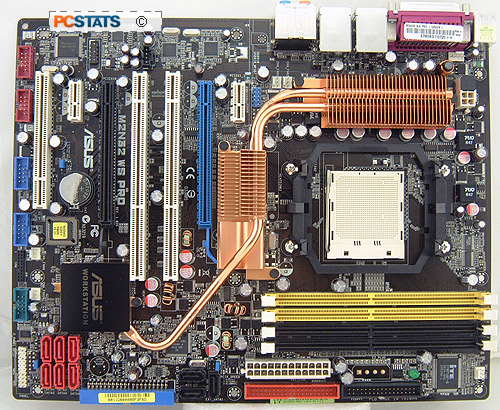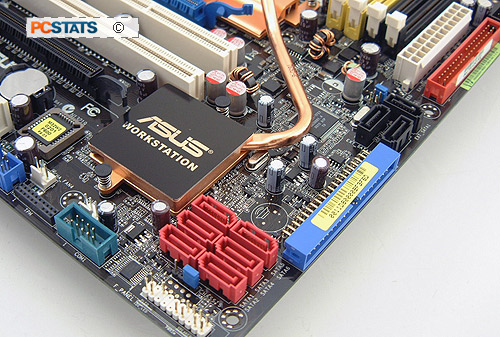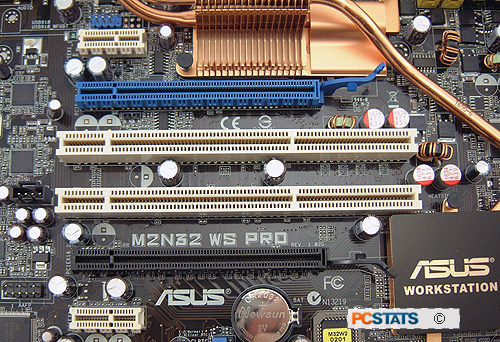It may be long forgotten now, but the Athlon64 was AMD's
breakthrough processor. With the K8 architecture AMD presented a legitimate challenge to
Intel's Pentium family, not just on the desktop front but also on the workstation and server markets too. One of the biggest questions posed at the time of this CPUs introduction was whether AMD's partners could deliver a mission critical chipset, core logic reliable enough to make the K8 architecture shine. That challenge was answered by nVIDIA, eventually. Pretty much all of AMD's success with the Athlon64 processor can be tied directly to one nVIDIA chipset or another.
Asus is one of the few manufacturers to have released a
nVIDIA nForce 590 SLI based workstation motherboard that's exactly what businesses
need. Not gamers. The Asus M2N32 WS Professional is a cross between a high end
desktop and workstation platform. It's perfect for those who work at home, or
run advanced systems for CAD, 3D animation, video editing, or simply require a
lot of computing power and very specific expansion options.
With a retail price of
$321 CDN ($276 US, £141 GBP), the Asus M2N32 WS Professional is certainly in
the right side of the fence and comes with a lot of integrated goodies. From
the external SATA port, the two 64-bit PCI-X slots, six 3GB/s SATA II channels
with support for RAID 0, 1, 0+1, 5, JBOD, dual Gigabit network ports, a silent chipset cooling system on the boards' 8-phase power supply, dual PCI Express x16 videocard SLI compatibility, 7.1 channel High Definition Azalia audio, dual IEEE 1394a ports, and 10 USB 2.0 slots, the board has almost everything a professional needs.
The Asus M2N32 WS
Professional motherboard is based on the nVidia nForce 590 SLI (C51XE) and nVidia
MCP55PXE Southbridge. The PCI-X bridge is a NEC PD720404 controller. Of
course, when the need arises to expanded, the Asus M2N32 WS Professional motherboard, there are a pair of PCI Express x1 slots, two PCI Express x16 slots, one 32 bit PCI slot and the two 64 bit PCI-X slots for high performance hardware. The last bit is important since there is a ton of workstation hardware that relies on the PCI-X architecture.
 |
|
Asus M2N32 WS Professional Motherboard |
|
|

 |
| Includes: |
|
User's Manual, Driver CD, WinDVD Media Suite
CD, Ultra/133 IDE Cable, Floppy Cable, seven Serial ATA
Cables, Four Molex to Serial ATA Converter Cables, USB Header,
IEEE 1394a Header, COM port Header, Q Connector, I/O
Shield |
 | | |
The M2N32 WS Professional motherboard supports all Socket AM2 Athlon64/X2/FX or Sempron processors, along with up to 8GB of unbuffered ECC/non-ECC DDR2-800 memory. This platform is compatible with the AMD64 architecture, enabling simultaneous 32-bit and 64-bit computing.
Around back at the rear IO ports, it's nice that Asus
places four USB slots along with an eSATA port here. PCSTATS would have liked to find at least one of the two IEEE 1394a ports located at the rear of the motherboard, rather than only at the brackets via motherboard headers. The rear I/O also has a parallel printer port, and coaxial audio out and SP/DIF optical audio out as well.
 Both Marvell
88E1116 Gigabit network cards run through the PCI Express bus. This reduces the
potential for issues with bandwidth.
Both Marvell
88E1116 Gigabit network cards run through the PCI Express bus. This reduces the
potential for issues with bandwidth.
Workstation systems often have large storage capacities and Asus integrates a
four port Marvell 8SE614x PCI Express-based Serial ATA controller onto the
motherboard.
Three SATA slots are available internally, the fourth slot is on the rear
I/O. In addition to the 10 Serial ATA II channels in total the Asus M2N32 WS
Professional motherboard supports, there is also an extra IDE slot. If you
recall, the nForce 590 SLi is only equipped with one IDE channel.
Asus includes pretty much everything you'd need to take advantage of the onboard peripherals in the box. We find nine Serial ATA cables, Q Connector headers, a flexible SLI bridge, a stereo microphone and a pile of SATA power cables and other standard gear.
Power Requirements:
A high end workstation system using the Asus M2N32 WS
Professional motherboard will use a lot of power so you're advised to get at
least 400W power supply here. Legacy ATX 1.4 spec power supplies (given away by
a 20-pin main ATX power connector) are compatible with the Asus M2N32 WS
Professional motherboard.  Make sure there is 30A+ capacity on the 12V line, and that the 4-pin
molex (just above the main power jack) is also connected.
Make sure there is 30A+ capacity on the 12V line, and that the 4-pin
molex (just above the main power jack) is also connected.
On the whole, it's best to use an ATX 2.0 spec power supply (noted by the 24-pins of
its main ATX connector) power supply with the Asus M2N32 WS Professional motherboard. The
modular cable Seasonic M12 700W, or PC Power & Cooling's monster Turbo-Cool 510W Express/SLI are excellent options.
Either of those PSU's has the recommended ESP12V connector. Most
high end motherboards call for the EPS12V connector to deliver a
stable and sufficient supply of power to the CPU. When running two or more PCI
Express videocards, Asus recommends a 500W power supply at least.
PCI-X Slots For Workstation Tasks
For business applications which demand SCSI
configurations, or professional grade network cards, the Asus M2N32 WS
Professional has two PCI-X slots located just below the blue PCI Express x16
slot. Each 3.3V 64 bit PCI -X slot operates at 66 MHz, which means each can support a theoretical maximum bandwidth of 250MB/s. This works out to the same as a PCI Express x1 connection, but obviously the list of supported PCI-X devices is much more substantial than PCI Express x1 devices at this point in time.

A pair of PCI-X slots allows the M2N32 WS
Professional motherboard to work with typical workstation and server hardware without running into bandwidth issues. For instance, a 10Gb Ethernet card or dual channel SCSI RAID controller is a lot more common in a PCI-X form factor than PCI Express. It can also be looked at as a simple way to upgrade older workstation platforms without having to replace expensive enterprise legacy hardware.

